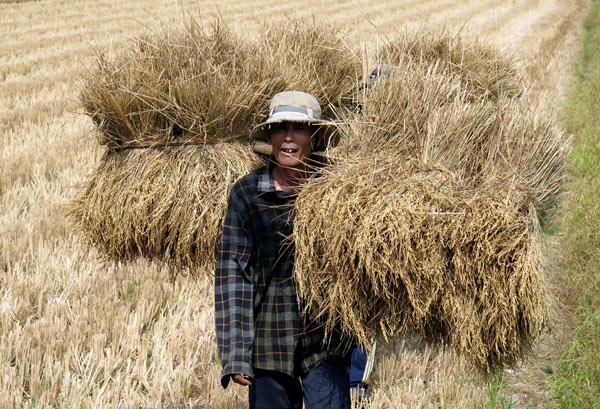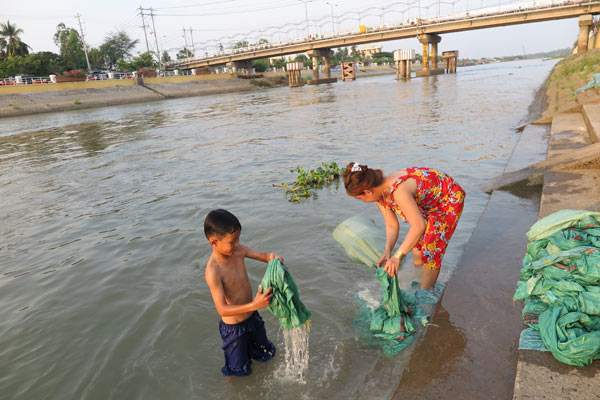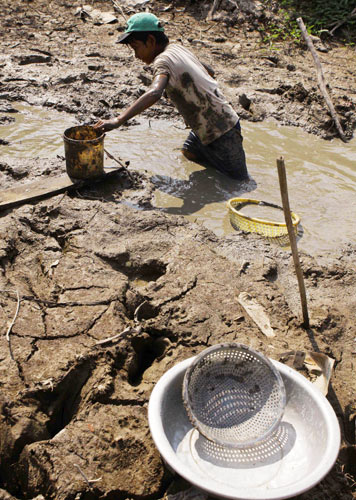
8 Apr, 2016
China doubles dam water release to help drought-hit Vietnam
Beijing, 7 April 2016, (China Daily) – The village where Vo Linh Hue lives is dotted with oyster farms, but in recent weeks farmers there have done nothing but clear dead oysters from the ponds. Ben Tre province, in Vietnam’s southern Mekong Delta, is experiencing the worst drought in recent history, and saline intrusion has hit rice and oyster farmers especially hard.
“This is the area where the river flows into the city. But now the seawater has pushed inland and killed all the oysters,” said Hue, 23, whose family lives in the Ben Tre village of Thua Thanh and has relied on oyster farming for decades.
At the request of Vietnam, China has doubled the amount of water being discharged from the Jinghong Hydropower Station, which is in Southwest China’s Yunnan province, to help alleviate the drought. The station is on the upper reaches of the river, which is known in China as the Lancang River.
 A farmer in Ben Tre province carries parched rice straw to feed cattle on Saturday. Vietnam has been struck by its worst drought in nearly a century and salinization of water is hitting farmers in the delta. China released an emergency water supply from its Jinghong Hydropower Station in Yunnan province to feed the downstream Mekong River from March 15 to April 10 to alleviate the devastating situation. Photos by Xinhua, Wang Jian / China Daily and provided to China Daily. |
Between March 15 and April 10, the volume of water discharged from the station is to be about three to three-and-a-half times the normal water flow, according to China’s Ministry of Water Resources.
The first water discharged by China had already arrived at the section of the Mekong River in Vietnam as of Monday, according to Vietnam News Agency.
Tran Duc Cuonga, a senior official with the Mekong River Commission in Vietnam, said on Tuesday that the water discharged by China can supply the section of the river in his country until April 29.
The discharge can help reduce the intrusion of saltwater by six to 10 kilometers in several tributaries of the Mekong River, he told VNA.
“Even though the discharge will not completely solve the drought and saline intrusion problems, it will alleviate them,” he said.
 A woman and her son wash bags in the Mekong River on Monday. Photos by Xinhua, Wang Jian / China Daily and provided to China Daily |
The emergency water supply has given a ray of hope to many rice farmers, who are on the verge of crop failure amid the severe drought.
Nguyen Thi Lua, a rice farmer in the provincial capital, Ben Tre, said she hopes the water from China can help save some of the rice paddies.
“It will not rain soon. So, if water discharged from China’s dam comes here, even if there is no rain, the water will help ordinary people like us to save rice fields, and cut costs on water for domestic use and on animal feed, making our daily lives better,” she told Xinhua News Agency.
However, some farmers in Ben Tre province said the drought is so severe that the discharge cannot completely solve the problems.
“I have heard the news that China has increased the amount of water discharged to the lower reaches. But it is too far away from here. Even if the water flows to here, it would be far from enough to stop the inland saline intrusion,” said a young resident of Ap Thua Thanh village who requested anonymity.
Due to saline intrusion, the river and underground water in Ben Tre province’s rural coastal areas can no longer be used for drinking or irrigation.
Many residents have had to buy fresh water from deep wells, according to Xinhua.
Zhang Boting, a senior researcher at the China Society for Hydropower Engineering, said it is unrealistic to rely on water discharged from the dam in China to eliminate the drought in the lower reaches of Vietnam.
 A boy looks for fish in a nearly dry canal in the Long Phu district in the Mekong Delta province of Soc Trang in early March. Photos by Xinhua, Wang Jian / China Daily and provided to China Daily |
“We need to keep in mind that the water volume of the Lancang River in China is less than 20 percent of the total water volume of the Mekong River,” he said.
Zhang said other countries that have tributaries of the Mekong must step up efforts to store more water during flood season to help alleviate drought during the river’s dry season.
Vietnamese Deputy Prime Minister and Foreign Minister Pham Binh Minh told VNA that, since China’s increased water release, Laos has followed its example and released water from its dams, further helping to increase the Mekong’s water level.



Liked this article? Share it!